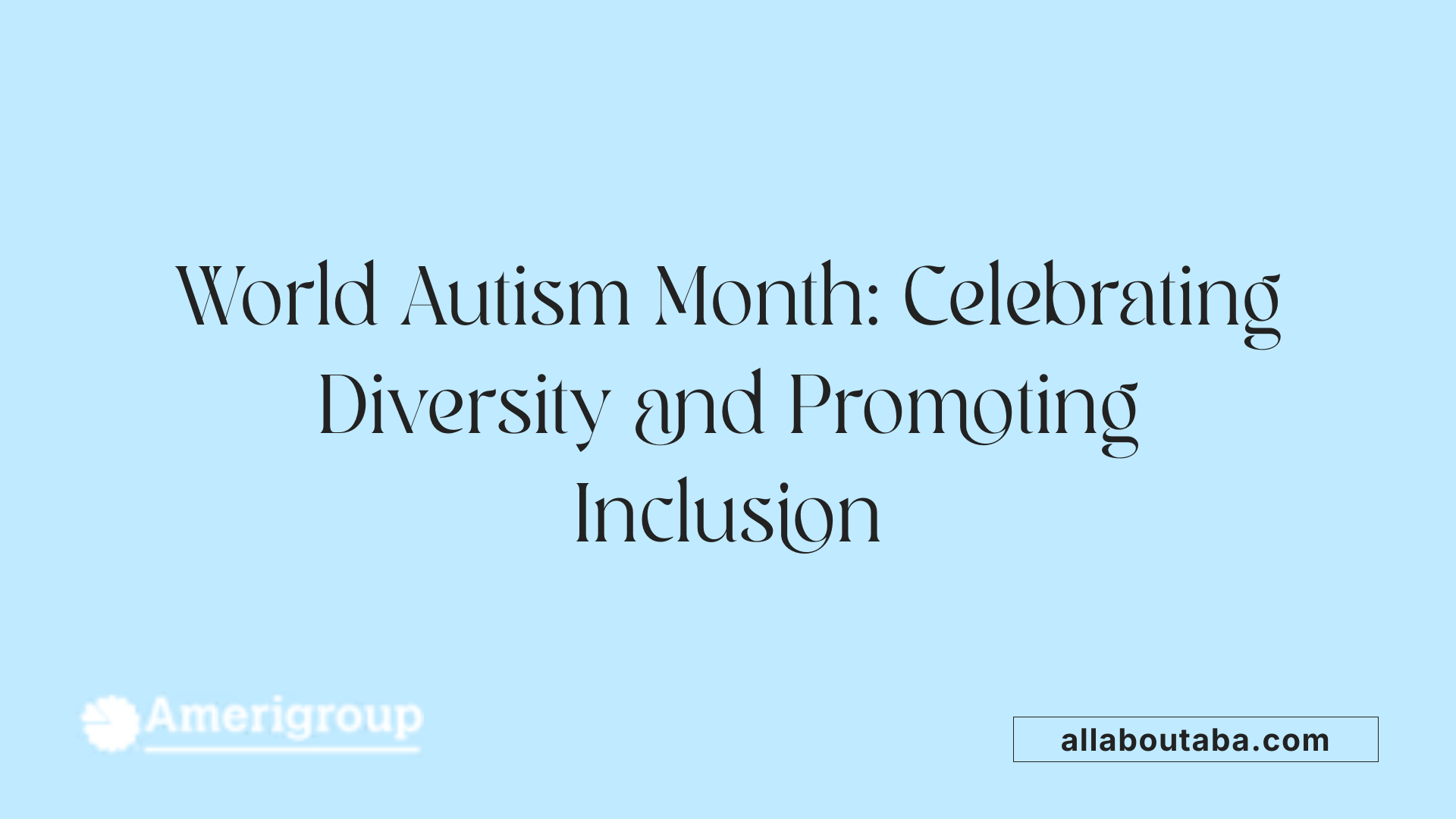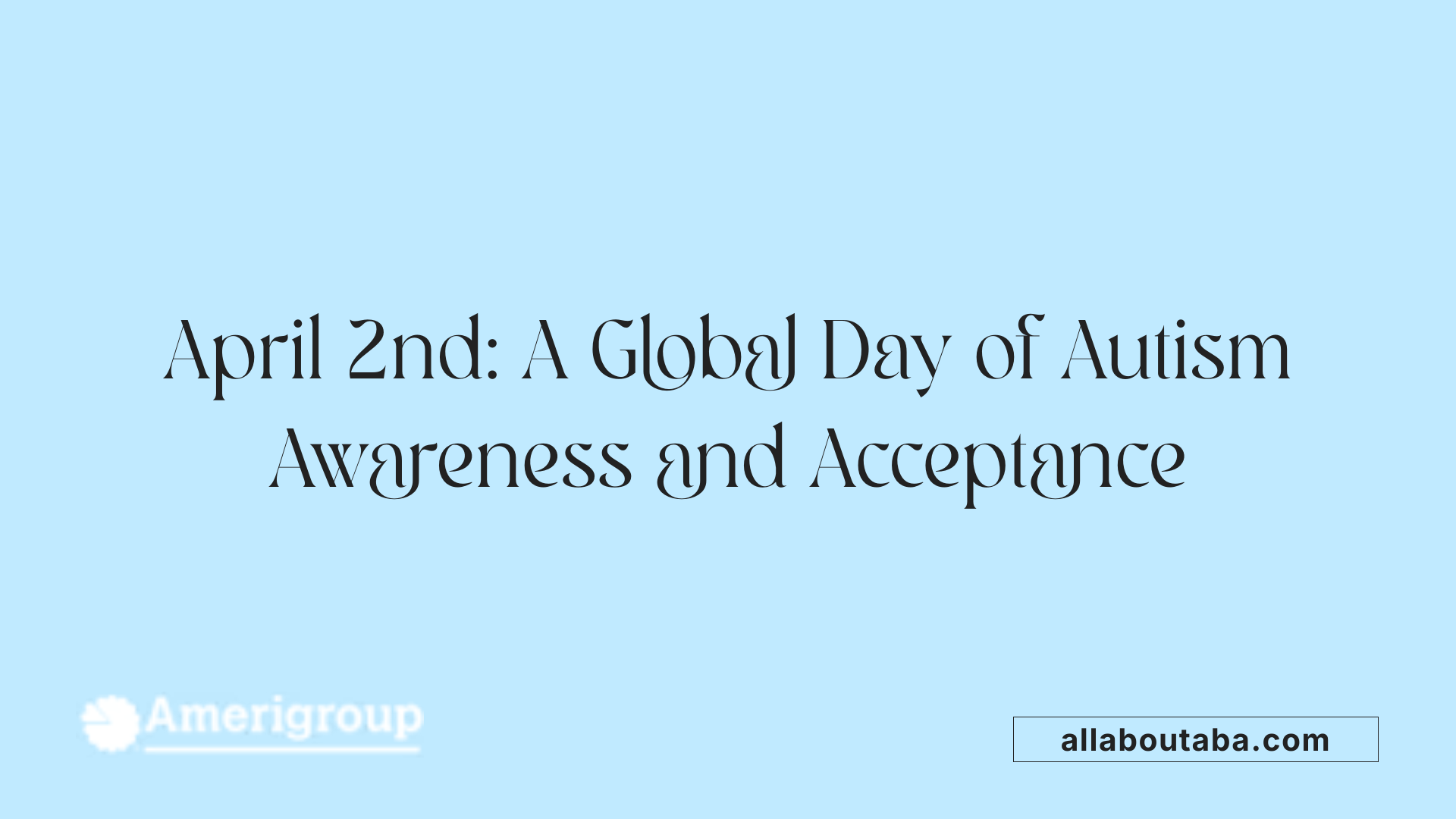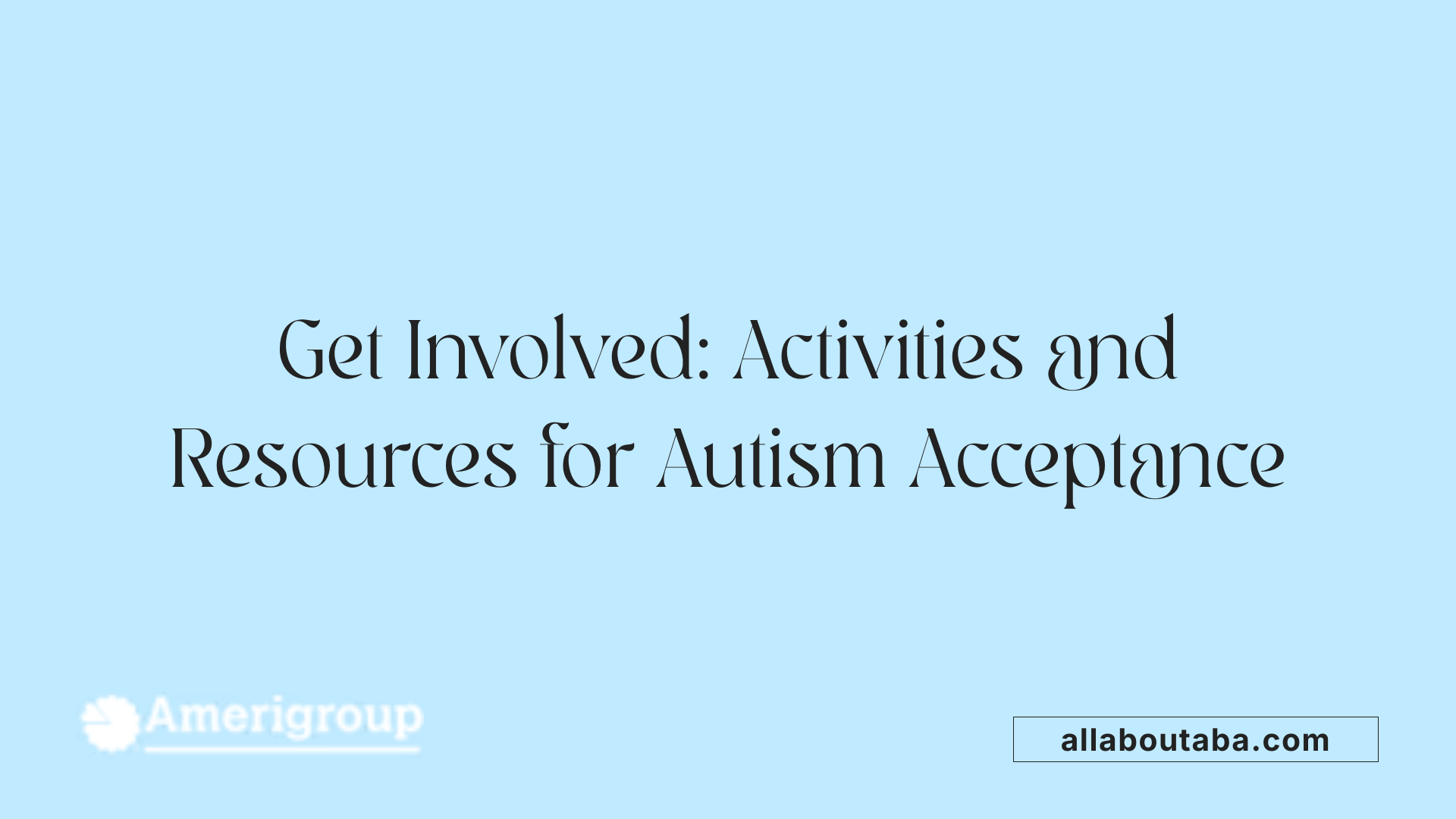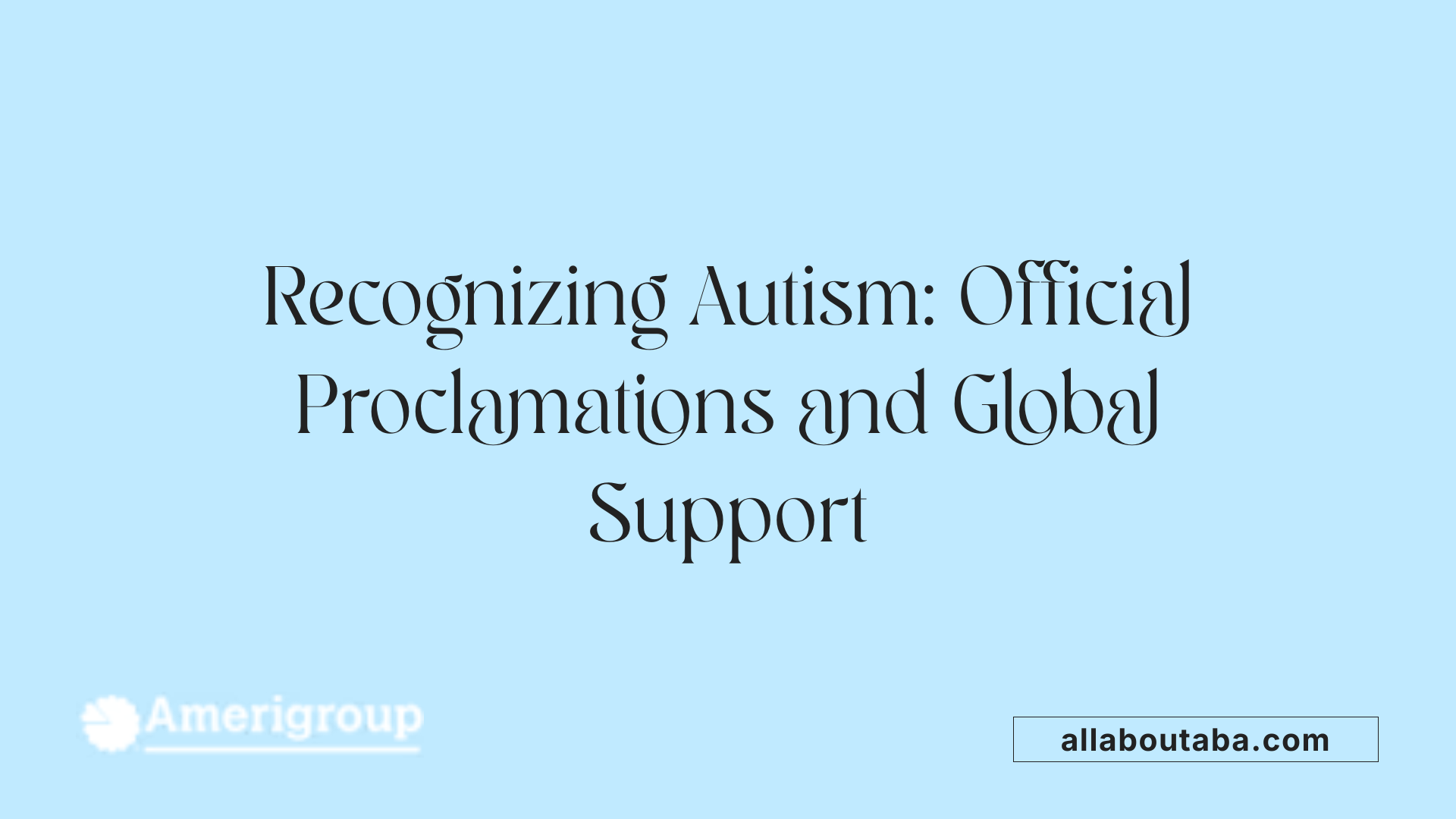World Autism Month
Understanding the Significance of April in the Autism Community
April marks a dedicated time for global reflection, awareness, and action as the world observes Autism Month, culminating in World Autism Awareness Day on April 2nd. This month-long initiative promotes understanding, acceptance, and support for individuals on the autism spectrum, emphasizing their rights and contributions to society. Over the years, efforts by organizations such as Autism Speaks, the CDC, and the United Nations have been instrumental in transforming perceptions of autism from mere awareness to embracing neurodiversity and inclusion.
What is World Autism Month, and what is its purpose and significance?

Definition of World Autism Month
World Autism Month is an annual observance held every April to increase awareness, understanding, and acceptance of autism spectrum disorder (ASD). It begins with the United Nations-sanctioned World Autism Awareness Day on April 2nd. The month serves as a platform for organizations, communities, and individuals to share stories, promote inclusivity, and support those on the autism spectrum.
Evolution from Autism Awareness to Autism Acceptance
Originally called Autism Awareness Month, this campaign shifted focus over the years to emphasize acceptance, understanding, and celebration of neurodiversity. In 2007, the Autism Society of America launched Autism Awareness Month, and by 2011, the terminology evolved towards Autism Acceptance Month. This change reflects a move away from viewing autism solely as a disease to recognizing it as a different way of being.
The 2024 theme, "Celebrate Differences," exemplifies this shift, encouraging society to embrace various autism-related differences and strengths. The focus now is on fostering supportive environments where autistic individuals can thrive, rather than solely raising awareness about the conditions.
Goals of the Month-Long Observance
Throughout April, various activities aim to educate, advocate, and promote inclusivity. These include fundraising events, awareness campaigns, and advocacy efforts encouraging support through donations, social media sharing, and participation in pledges like #GoBlue. The CDC and other organizations promote resources like milestone tracking tools and early intervention programs to assist families and service providers.
An essential goal is to break down barriers—whether in education, employment, healthcare, or social settings—creating opportunities for individuals with autism to reach their full potential.
Impact on Society's Perceptions and Support Systems
Autism Acceptance Month plays a crucial role in transforming societal perceptions by challenging stereotypes and promoting acceptance. Recognizing autism as a spectrum highlights the diversity within the autism community—some children with autism have above-average intelligence, while others face significant challenges.
The increased awareness fosters a more inclusive society, encouraging modifications in workplaces, schools, and healthcare to better support autistic individuals. It also amplifies autistic voices, advocates for policy changes, and boosts mental health and well-being by reducing stigma and discrimination.
Overall, World Autism Month contributes to building understanding, acceptance, and stronger support systems that uphold the rights and dignity of autistic individuals across the globe.
Symbolism and Campaigns Promoting Autism Awareness
 The color blue plays a central role in autism awareness initiatives, embodying a sense of calm, acceptance, and understanding. This significance is prominently showcased in the 'Light It Up Blue' campaign launched by Autism Speaks, which encourages individuals and landmarks worldwide to glow blue during April, especially on World Autism Awareness Day. By illuminating buildings and landmarks, the campaign visually demonstrates solidarity and brings public attention to autism issues.
The color blue plays a central role in autism awareness initiatives, embodying a sense of calm, acceptance, and understanding. This significance is prominently showcased in the 'Light It Up Blue' campaign launched by Autism Speaks, which encourages individuals and landmarks worldwide to glow blue during April, especially on World Autism Awareness Day. By illuminating buildings and landmarks, the campaign visually demonstrates solidarity and brings public attention to autism issues.
Beyond the blue hue, symbols such as puzzle pieces, rainbow colors, and infinity signs have gained prominence in representing autism. The puzzle piece has historically symbolized the complexity and diversity of the spectrum, highlighting the idea that each autistic individual is unique. Rainbow colors emphasize diversity and inclusion, celebrating the wide range of skills and challenges faced by autistic people. The infinity symbol is increasingly used to signify neurodiversity and the endless possibilities of individuals on the spectrum.
Community-driven activities also play a vital role in awareness campaigns. Many cities host festivals, walks, and public lightings on landmarks to foster community involvement and visibility. Social media campaigns encouraging sharing stories and images, such as the use of specific hashtags, help to unify voices worldwide. The integration of symbols and colors into public landmarks and personal expressions creates a vibrant visual narrative that promotes acceptance and understanding of autism.
| Symbol/Color | Significance | Examples of Use |
|---|---|---|
| Blue | Calming, acceptance, support | 'Light It Up Blue' campaign, landmarks lighting, apparel |
| Puzzle Pieces | Diversity, complexity of autism | Logos, flags, awareness ribbons |
| Rainbow Colors | Diversity, neurodiversity | Flags, artwork, awareness merchandise |
| Infinity Sign | Neurodiversity, limitless potential | jewelry, logos, campaign materials |
| Community Landmarks | Visibility, solidarity | Buildings, bridges, statues lit up during awareness events |
The combination of these symbols and community activities ignites interest and understanding, transforming public spaces into expressions of support. They serve as powerful visual cues that foster awareness, acceptance, and celebration of the diversity within the autism spectrum.
Key Dates and Global Recognition of Autism

What is the significance of April 2nd for autism awareness?
April 2nd holds profound importance worldwide as it marks World Autism Awareness Day. This special day was officially designated by the United Nations in 2007 with the goal of increasing global understanding, acceptance, and support for autistic individuals. It serves as a focal point to raise awareness about autism, which affects approximately 1 in 36 children in the United States alone, according to CDC estimates in 2023.
The day encourages societies to promote inclusion, equality, and recognition of neurodiversity. Activities like the "Light It Up Blue" campaign, where landmarks and buildings are illuminated in blue, aim to spotlight autism and challenge misconceptions. It also promotes various community-led initiatives, educational campaigns, and advocacy efforts to enhance accessibility and resources for autistic individuals.
Over the years, the observance of April 2nd has evolved from merely raising awareness to emphasizing acceptance and celebration of differences. This shift aligns with global movements to view autism through a lens of neurodiversity, recognizing the unique strengths and perspectives autistic people bring. Ultimately, April 2nd fosters a worldwide dialogue on improving the lives of autistic individuals through policy change, societal support, and personal understanding.
Global observance and proclamations by UN and governments
The significance of April 2nd has been universally recognized through proclamations by the United Nations and many national governments. Since its establishment, the UN has supported initiatives that promote not only awareness but also acceptance, inclusion, and human rights for autistic people. Each year, the UN flags theme-specific events, such as "Transforming the Narrative" in 2023 and "Advancing Neurodiversity and the UN Sustainable Development Goals (SDGs)" in 2025.
Numerous countries, including the United States, Canada, and North Carolina, have issued official proclamations declaring April as Autism Awareness or Autism Acceptance Month. For instance, in 2025, North Carolina’s governor proclaimed April as a month dedicated to recognizing the needs and contributions of autistic individuals, coupled with initiatives to enhance services and employment opportunities.
International organizations and community groups organize conferences, panels, and campaigns to reinforce the global commitment to support autistic individuals. These efforts foster a culture of understanding, reduce stigma, and promote policies that facilitate access to education, healthcare, and employment. Through these widespread celebrations and declarations, April 2nd serves as a unifying occasion for the world to honor the neurodiverse community and advocate for ongoing progress.
Activities, Resources, and Ways to Support during World Autism Month
 'Autism Awareness Month' has evolved into 'Autism Acceptance Month,' emphasizing understanding, compassion, and inclusion. Throughout April, many organizations host diverse activities to raise awareness, promote acceptance, and support autistic individuals.
'Autism Awareness Month' has evolved into 'Autism Acceptance Month,' emphasizing understanding, compassion, and inclusion. Throughout April, many organizations host diverse activities to raise awareness, promote acceptance, and support autistic individuals.
Fundraising events, advocacy campaigns, and community activities are central to this effort. Examples include charity walks, challenge events, and creative projects that engage local communities and inspire action. These initiatives often encourage participants to share their experiences on social media platforms using hashtags like #AutismAcceptanceMonth and #AutismAwareness. Supporting awareness are campaigns such as lighting landmarks blue or wearing autism symbols, particularly during the Light It Up Blue campaign.
Educational resources and toolkits are also widely distributed to promote understanding. Resources like the CDC's Autism Partner Toolkit offer guidance for schools, workplaces, and families on fostering inclusion. Books such as 'Uniquely Human' or 'Magnificent Minds' provide personal insights and strategies to support autistic individuals.
Early diagnosis and intervention are crucial, and support tools like CDC’s Milestone Tracker app help caregivers and educators monitor developmental milestones. Promoting early identification and providing access to services are vital steps that aid children and young adults in reaching their full potential.
Individuals can actively participate in numerous ways. Engaging in fundraising activities such as walks or online challenges helps raise money for crucial services. Sharing personal stories and success stories, especially on social media, aids in destigmatizing autism and fostering acceptance. Wearing blue or displaying autism-friendly symbols can be a simple yet powerful gesture.
Volunteering at local events or supporting organizations through donations contributes significantly. People can initiate their own awareness campaigns, distribute educational materials, and encourage early screening and intervention within their communities.
Supporting employment initiatives and resources for autistic youth and adults also promotes overall inclusion. Programs aimed at increasing employment opportunities and providing skills training help break barriers faced by many on the spectrum.
Together, these activities and efforts build a more accepting society—one that understands and values the neurodiversity of all individuals.'
Official Recognitions and Their Role in Autism Advocacy

Are there official proclamations or recognitions of World Autism Month?
Yes, there are official proclamations and recognitions of World Autism Month. In the United States, April has been officially recognized as Autism Acceptance Month since 1988 through a presidential proclamation, which emphasizes the importance of awareness, acceptance, and support for individuals with autism.
Globally, the United Nations plays a significant role in formalizing autism awareness. Since 2007, the UN General Assembly has designated April 2nd as World Autism Awareness Day. This international observance encourages member states to promote education, acceptance, and inclusion of autistic individuals across the world.
The 2025 UN theme focuses on 'Advancing Neurodiversity and the UN Sustainable Development Goals (SDGs),' further highlighting the global commitment to promoting human rights and accessibility.
Supported by organizations such as Autism Speaks, the Autism Society of America, and the UN, these official recognitions help to coordinate worldwide campaigns, events, and initiatives during April and on April 2nd.
In 2025, the President of the United States issued a proclamation reaffirming this commitment, stressing the importance of early detection, intervention, and inclusion. Such recognitions serve to elevate the visibility of autism, inspire policy changes, and foster community-based support systems.
Overall, these official proclamations serve as vital tools in raising awareness, shaping policies, and mobilizing resources to improve the lives of autistic individuals and their families.
Continual Advocacy and Global Impact
As the world observes April as Autism Month, the collective efforts of organizations, governments, and communities continue to enhance acceptance, support, and inclusion for autistic individuals. Recognizing the spectrum's diversity, initiatives like World Autism Awareness Day and advocacy campaigns are vital in fostering understanding and breaking down barriers. Moving forward, ongoing education, policy change, and societal acceptance will be essential in creating a world where every individual with autism can thrive, be understood, and celebrated for their unique contributions.
References
- World Autism Month - Autism Speaks
- World Autism Month - American Autism Association
- Autism Partner Toolkit | Autism Spectrum Disorder (ASD) - CDC
- Autism Acceptance Month 2025 - Cerebral Palsy Guide
- Autism Acceptance Month: The History and Impact - Neurology Advisor
- Autism Acceptance Month and World Autism Awareness Day 2025
- Autism Acceptance Month - Autism Society
Other articles
Recent articles

How Schools Can Support Autistic Students In Career Prep

Best Strategies For Autism-Friendly Event Planning

Understanding Noncontingent Reinforcement In Autism Behavior Plans

How Drama Therapy Benefits Autistic Individuals

Best Practices For Autism-Friendly Fitness And Recreation Centers

Best Ways To Promote Healthy Social Media Use For Autistic Teens

How To Help Autistic Children Cope With Public Speaking

Autism And Strategies For Managing Unexpected Changes

Best Podcasts About Autism For Parents And Educators

Autism And The Impact Of Seasonal Changes On Behavior

The Role Of Diet In Managing Co-Occurring Conditions With Autism

Sleep Challenges In Autism And Practical Solutions

Best Ways To Build Daily Routines For Autistic Children

Best Practices For Supporting Autistic Entrepreneurs

Autism And Strategies For Navigating Large Social Gatherings

Adaptive Sports And Recreational Activities For People With Autism

Autism And The Benefits Of Story-Based Learning Activities

Understanding The Role Of Play In Autism Development

Autism And The Impact Of Environmental Noise On Learning

How To Create Autism-Friendly Community Spaces

Autism And Chronic Health Conditions: What To Know

The Role Of Care Managers In Autism Life Planning

How To Teach Social Boundaries To Autistic Children

How Autistic Individuals Experience Empathy Differently

How To Support Autistic Employees In Remote Work Settings

Autism And The Relationship Between Motor Skills And Learning

How To Create Community Resource Guides For Autism Families

How To Teach Daily Living Skills To Autistic Teens

Autism And The Impact Of Mind-Body Practices On Stress Reduction

Autism And The Benefits Of Outdoor Group Activities

How To Create Autism-Friendly Sensory Paths In Schools

Best Practices For Autism-Friendly Park And Recreation Areas

Autism And Strategies For Reducing School Refusal

Supporting Autistic Individuals In Public Speaking

The Role Of Diet In Managing Autism Symptoms

The Benefits Of Gardening Clubs For Autism Social Development

How To Prepare Autistic Children For Dental Visits

Autism And Employment: Career Paths That Work

Best Practices For Autism-Friendly Hotels And Lodging

The Impact Of Screen Time On Autism Development

Autism Screening Tools For Early Childhood

The Role Of Physical Exercise In Autism Therapy

Best Strategies For Supporting Autistic College Students

The Role Of Technology In Autism Early Detection

Sensory-Friendly Classroom Design Ideas For Autistic Students

The Role Of Speech Therapy In Building Social Communication Skills

Best Strategies For Handling Autistic Burnout In Adults

Autism And The Importance Of Predictability In Routine

Autism And Peer Education: Teaching Acceptance In Schools

Best Practices For Sensory-Friendly Libraries And Reading Rooms

Self-Advocacy Skills For Autistic Adults

The Role Of Technology In Autism Peer Communication

Promoting Physical Activity In Children With Autism

How To Prepare Autistic Children For Medical Procedures

The Role Of Social Media In Autism Advocacy And Awareness

The Impact Of Sensory Rooms In Public Facilities For Autism

How To Create An Autism-Friendly Holiday Celebration

Best Practices For Inclusive Education For Autistic Students

Autism And Mental Health: Recognizing Signs Of Distress

Best Practices For Sensory-Friendly Waiting Rooms

The Role Of Teachers In Early Autism Red Flag Identification

Autism-Friendly Housing Design Features

Autism-Friendly Housing Design Features

How Environmental Modifications Improve Autism Outcomes

Autism And Technology-Based Learning Tools

Supporting Autistic Children Through Changes In Routine

The Link Between Autism And Working Memory Challenges

Best Practices For Autism-Friendly Cooking Classes

Autism And The Benefits Of Structured Music Lessons

Best Books To Teach Kids About Autism Acceptance

Sensory Diets And Their Benefits For Autism Management

How To Prepare Autistic Teens For Driver’s Education

How To Teach Autistic Teens About Healthy Relationships

The Role Of Visual Prompts In Building Daily Habits For Autism

Addressing Sleep Regression In Children With Autism

Understanding Social Stories And How They Help Autistic Children

Navigating Insurance Coverage For Autism Therapy Services

How To Prepare Autistic Adults For Independent Travel

Supporting Autistic Individuals In Volunteer Work

How Mindfulness Practices Can Support Autism Well-Being

Understanding Hyperfocus And Special Interests In Autism

Understanding Stimming As A Self-Regulation Tool

Sensory-Based Interventions For Autism At Home

Best Ways To Introduce Self-Advocacy In Autistic Teens

Best Ways To Support Autistic Employees In Customer Service Roles

Best Practices For Autism-Friendly Volunteer Programs

Autism And The Benefits Of Sensory Play For Emotional Growth

Autism And Strategies For Building Peer Relationships

Understanding How Autism Affects Memory Processing

Autism And Strategies For Building Coping Skills In Teens

The Role Of Parent Training In Autism Intervention Programs

Autism-Friendly Workplace Accommodations

Using Visual Timers For Autism Time Management

What Is ABA Therapy?

Autism and Sleep

Do Plastic Toys Cause Autism?

Autism Facial Expressions

Autism and Motor Skills

Which Parent Carries The Autism Gene?

Autism Symbols & Colors
We’re All About You, Your Family, and Your Child

